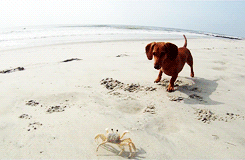
It’s easy to spot in a moving dog. In “dog speak,” crabbing is when a dog should be moving in a straight line, but instead, he seems to be moving at an angle to the line of travel much like a crab (for this reason, this movement is also called “sidewinding).
This kind of gait can come from muscle strain, spinal injury, habit, or bad handling, but it can also occur when a dog wants to avoids “collisions” between his front legs and his rear legs, and that’s a structural issue.
Normally, a dog’s legs move diagonally in two beats with legs working as a pair First, the right front and left
rear are lifted while the other two feet are touching the ground, and then, the left front, right rear are lifted while the other two are on the ground. The feet need to land without hitting each other, and this means that the dog has to have enough reach in his front to move his front legs out of the way so there’s enough space for his rear legs to move forward without the dog stepping on himself. This is called “moving in the same planes, ” or as Dr. Carmen Battaglia has described it, it’s like the front and rear tires of a Jeep leaving behind only two trails in snow even though the Jeep has four wheels. It’s because the Jeep’s front and rear wheels are moving on the same plane.
Does it even matter to a dog that never sees the inside of a show ring? Answer your own question by moving to your refrigerator sideways instead of with a forward stride. Did it take you longer? Did it frustrate you?
